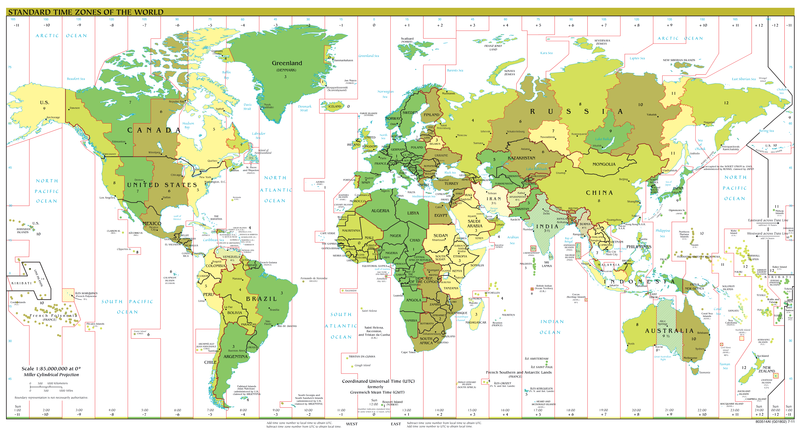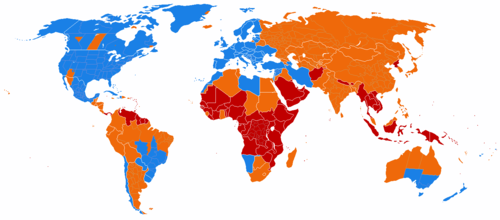Time clock standards
The western time standards dividesthe year into 12 months, the day into 24 hours or 12 hours AM and 12 hours PM, the hour into 60 minutes and the minute into 60 seconds derived from the Babylonian[1] mathematics using the sexagesimal[2] or base 60 numeral system.
- Note:
- The base 60 systems is a highly composite number as 1, 2, 3, 4, 5, 6, 10, 12, 15, 20, 30 and 60 are factors.
The length of a day
Defined in ISO 8601[3] the day consists of 24 hours consisting of 60 minutes of 60 seconds. giving a total of <math>24 * 60 * 60 = 86.400 </math> seconds a day. With the Earth rotation slowing[4] down there are two possible ways to make the clock time match the rotation of the Earth.
- Decreasing the length of the second to match 86400 second/day
- Introducing a leap second[5] when needed.
The length of a second
Historical
The second has been used approximately since year 1000, first used by the Persian scholar Al-Biruni[6] as the second division of 60 of the hour. From 1960 the length of second was defined as 1/86.000 of a mean solar day.
<math>\text{Seconds in a solar day} \eqcirc 24 \text{ hour } * \text{ }60 \text{ minute/hour } * \text{ } 60 \text{ second/minute } \eqcirc 86.400 \text{ seconds}</math>
Present day
To day the second is defined as the duration of 9.192.631.770 periods of the radiation corresponding to the transition between the two hyperfine levels of the ground state of the Caesium 133 atom[7][8].
Leap second

The length of a second is constant, based on the Caesium atom, so it is necessary to use leap seconds to synchronize the mean solar day to the clock time. The IERS[9] or International Earth Rotation and Reference Systems Service introduces leap seconds at various intervals. More than 30 leap seconds has been added since 1972 by IERS[10].
The Earth's rotation speed changes irregularly based on many factors[11] making it necessary for IERS to introduce a leap seconds at irregular intervals adding or substracting a second giving a day with 86.401 or 86.399 seconds, depending on the Earth's rotation.
- Adding a leap second adds the 61st second to the minute at midnight.
- 23:59:58 → 23:59:59: → 23:59:60 → 00:00:00
- Substracting a leap removes the 60th second from the minute before midnight.
- 23:59:58 → 00:00:00
Time Zones
A time zone[12] is a region of the earth where the time clock follows the sun so that 12:00 (noon) is in midday and 00:00 (midnight) is in the night. The time zone regions often follow borders of countries for commercial and social purposes.
The standard clock time is defined as UTC[13] succeeding GMT[14].
Time zones are described as offsets from UTC. For example Denmark is UTC+1, meaning when the time clock is 10:33 in Greenwich UK it is 11:33 in Denmark. IANA maintains a list of time zones[15].
DST or summer time
Daylight saving time (DST)[16]—also summer time in British English— is the practice of advancing clocks during the lighter months so that evenings have more daylight and mornings have less. Typically clocks are adjusted forward one hour near the start of spring and are adjusted backward in autumn.
Country DST
Each country decides for itself whether to use DST or not. DST rules can be changed as each county see fit.
Comparing times between time zones
To compare times between countries it is necessary to know the current DST rules for each involved country to agree on a exact common time. To compare times in a historical perspective it is necessary to know the historic DST rules for each involved country. IANA[17] tries to keep track of a historic database over DST rules[18]
Links
- leapsecond.com (See Localtime, UTC, GPS, Loran and TAI time)
References
- ↑ Babylonian mathematics
- ↑ Sexagesimal or base 60 numeral system
- ↑ ISO 8601
- ↑ Slowing down of the Earth
- ↑ Leap_second
- ↑ w:Abū_Rayḥān_al-Bīrūnī
- ↑ The unit of time - The second
- ↑ List of atomic clocks
- ↑ International Earth Rotation and Reference Systems Service]
- ↑ International Atomic Time
- ↑ ΔT - Earth's rotation variable speed
- ↑ Time zones
- ↑ UTC or Coordinated Universal Time
- ↑ GMT or Greenwich Mean Time
- ↑ List of times zones maintained by IANA
- ↑ Daylight saving time
- ↑ IANA Internet assigned Number Authority
- ↑ IANA historic database over DST rules

